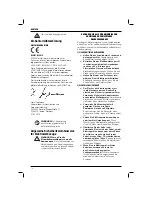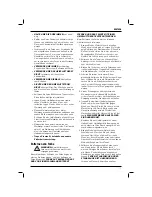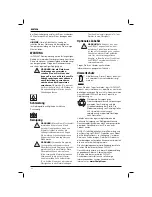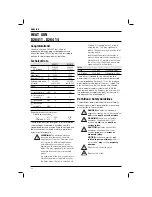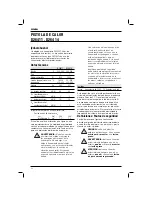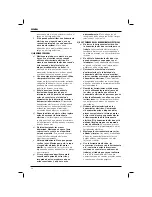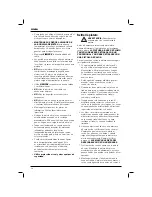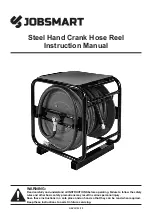
ENGLISH
26
d)
Remove any adjusting key or wrench
before turning the power tool on.
A
wrench or a key left attached to a rotating
part of the power tool may result in personal
injury.
e)
Do not overreach. Keep proper
footing and balance at all times.
This
enables better control of the power tool in
unexpected situations.
f)
Dress properly. Do not wear loose
clothing or jewellery. Keep your hair,
clothing and gloves away from moving
parts.
Loose clothes, jewellery or long hair
can be caught in moving parts.
g)
If devices are provided for the connection
of dust extraction and collection facilities,
ensure these are connected and properly
used.
Use of dust collection can reduce
dust-related hazards.
4) POWER TOOL USE AND CARE
a)
Do not force the power tool. Use the
correct power tool for your application.
The correct power tool will do the job
better and safer at the rate for which it
was designed.
b)
Do not use the power tool if the switch
does not turn it on and off.
Any power
tool that cannot be controlled with the switch
is dangerous and must be repaired.
c)
Disconnect the plug from the power
source and/or the battery pack from
the power tool before making any
adjustments, changing accessories, or
storing power tools.
Such preventive safety
measures reduce the risk of starting the
power tool accidentally.
d)
Store idle power tools out of the reach
of children and do not allow persons
unfamiliar with the power tool or these
instructions to operate the power tool.
Power tools are dangerous in the hands of
untrained users.
e)
Maintain power tools. Check for
misalignment or binding of moving parts,
breakage of parts and any other condition
that may affect the power tool’s operation.
If damaged, have the power tool repaired
before use.
Many accidents are caused by
poorly maintained power tools.
f)
Keep cutting tools sharp and clean.
Properly maintained cutting tools with sharp
cutting edges are less likely to bind and are
easier to control.
g)
Use the power tool, accessories and
tool bits etc., in accordance with these
instructions taking into account the
working conditions and the work to
be performed.
Use of the power tool for
operations different from those intended
could result in a hazardous situation.
5) SERVICE
a)
Have your power tool serviced by a
qualified repair person using only identical
replacement parts.
This will ensure that the
safety of the power tool is maintained.
Safety Instructions for Heat Guns
A fire may result if the appliance is not used with
care, therefore:
• Heat may be conducted to combustible
materials that are out of sight.
DO NOT
use in
a damp atmosphere, where flammable gases
may be present or near combustible materials.
•
DO NOT
apply to the same place for a long
time.
•
DO NOT
use in presence of an explosive
atmosphere.
• Place the appliance on its stand after use and
allow it to cool down before storage.
•
DO NOT
leave the tool unattended while it is
switched on.
•
DO NOT
place your hand over the air vents or
block the vents in any way.
• The nozzle and accessories of this tool become
extremely hot during use. Let these parts cool
down before touching.
•
ALWAYS
switch the tool off before putting it
down.
• This appliance is not intended for use by
persons (including children) with reduced
physical, sensory or mental capabilities, or lack
of experience and knowledge, unless they have
been given supervision or instruction concerning
use of the appliance by a person responsible for
their safety.
• Ensure adequate ventilation as toxic fumes may
be produced.
•
DO NOT
use as a hair dryer.
•
DO NOT
obstruct either the air intake or nozzle
outlet, as this may cause excessive heat build
up resulting in damage to the tool.
•
DO NOT
direct the hot air blast at other people.
•
DO NOT
touch the metal nozzle as it becomes
very hot during use and remains hot for up to
30 minutes after use.
•
DO NOT
place the nozzle against anything
while using or immediately after use.
Summary of Contents for D26411
Page 1: ...www eu D26411 D26414 ...
Page 3: ...1 Figure 1 a c b d e f g D26411 a c b d e f g D26414 h d ...
Page 4: ...2 Figure 2 Figure 3 Figure 4 A ...
Page 145: ...143 ...
Page 146: ...144 ...
Page 147: ...145 ...



